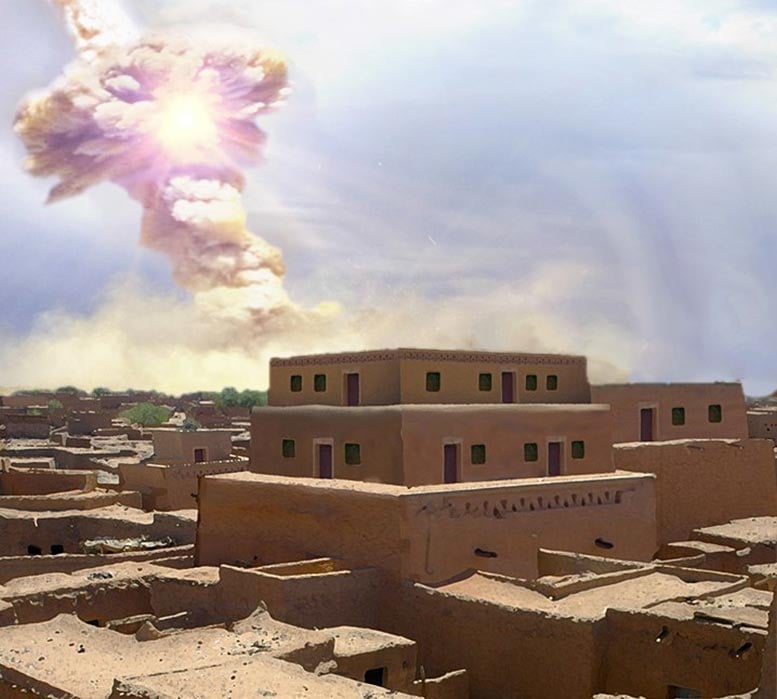
Posted on 09/27/2021 12:01:06 PM PDT by Red Badger

Artist’s evidence-based depiction of the blast, which had the power of 1,000 Hiroshimas. Credit: Allen West and Jennifer Rice
A giant space rock demolished an ancient Middle Eastern city and everyone in it – possibly inspiring the Biblical story of Sodom.
As the inhabitants of an ancient Middle Eastern city now called Tall el-Hammam went about their daily business one day about 3,600 years ago, they had no idea an unseen icy space rock was speeding toward them at about 38,000 mph (61,000 kph).
Flashing through the atmosphere, the rock exploded in a massive fireball about 2.5 miles (4 kilometers) above the ground. The blast was around 1,000 times more powerful than the Hiroshima atomic bomb. The shocked city dwellers who stared at it were blinded instantly. Air temperatures rapidly rose above 3,600 degrees Fahrenheit (2,000 degrees Celsius). Clothing and wood immediately burst into flames. Swords, spears, mudbricks, and pottery began to melt. Almost immediately, the entire city was on fire.
Some seconds later, a massive shockwave smashed into the city. Moving at about 740 mph (1,200 kph), it was more powerful than the worst tornado ever recorded. The deadly winds ripped through the city, demolishing every building. They sheared off the top 40 feet (12 m) of the 4-story palace and blew the jumbled debris into the next valley. None of the 8,000 people or any animals within the city survived – their bodies were torn apart and their bones blasted into small fragments.
About a minute later, 14 miles (22 km) to the west of Tall el-Hammam, winds from the blast hit the biblical city of Jericho. Jericho’s walls came tumbling down and the city burned to the ground.
It all sounds like the climax of an edge-of-your-seat Hollywood disaster movie. How do we know that all of this actually happened near the Dead Sea in Jordan millennia ago?
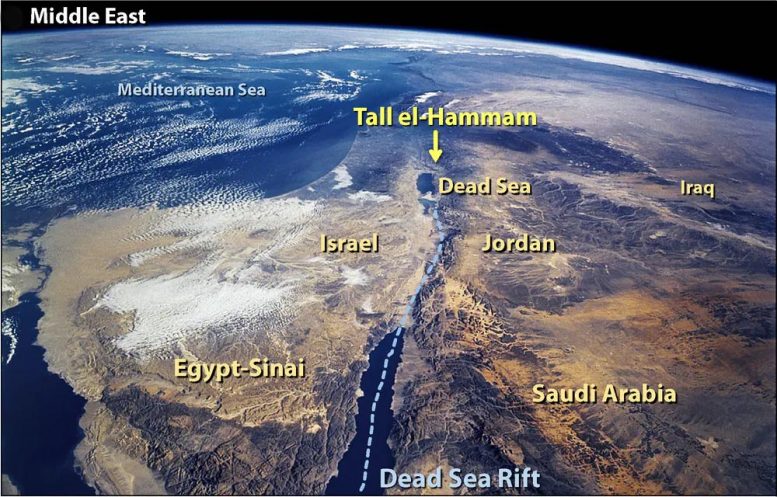
Now called Tall el-Hammam, the city is located about 7 miles northeast of the Dead Sea in what is now Jordan. Credit: NASA
Getting answers required nearly 15 years of painstaking excavations by hundreds of people. It also involved detailed analyses of excavated material by more than two dozen scientists in 10 states in the U.S., as well as Canada and the Czech Republic. When our group finally published the evidence recently in the journal Scientific Reports, the 21 co-authors included archaeologists, geologists, geochemists, geomorphologists, mineralogists, paleobotanists, sedimentologists, cosmic-impact experts and medical doctors.
Here’s how we built up this picture of devastation in the past.
Firestorm throughout the city Years ago, when archaeologists looked out over excavations of the ruined city, they could see a dark, roughly 5-foot-thick (1.5 m) jumbled layer of charcoal, ash, melted mudbricks and melted pottery. It was obvious that an intense firestorm had destroyed this city long ago. This dark band came to be called the destruction layer.
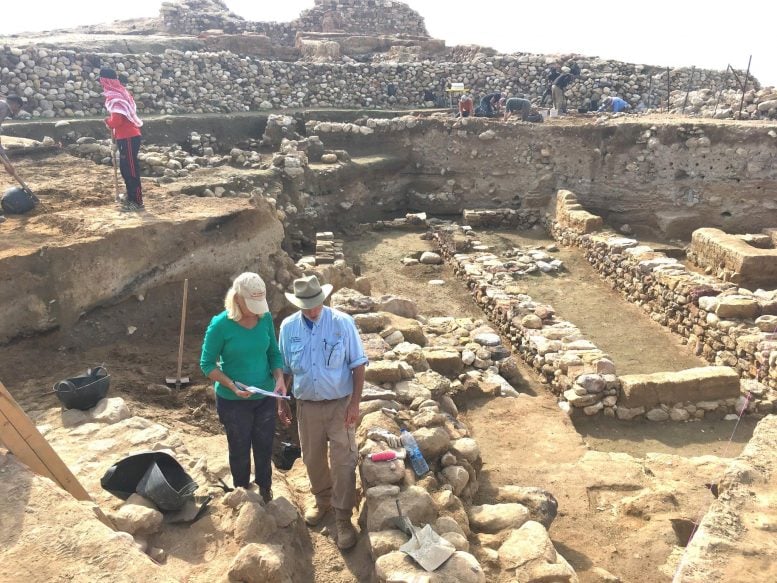
Researchers stand near the ruins of ancient walls, with the destruction layer about midway down each exposed wall. Credit: Phil Silvia
No one was exactly sure what had happened, but that layer wasn’t caused by a volcano, earthquake or warfare. None of them are capable of melting metal, mudbricks and pottery.
To figure out what could, our group used the Online Impact Calculator to model scenarios that fit the evidence. Built by impact experts, this calculator allows researchers to estimate the many details of a cosmic impact event, based on known impact events and nuclear detonations.
It appears that the culprit at Tall el-Hammam was a small asteroid similar to the one that knocked down 80 million trees in Tunguska, Russia in 1908. It would have been a much smaller version of the giant miles-wide rock that pushed the dinosaurs into extinction 65 million ago.
We had a likely culprit. Now we needed proof of what happened that day at Tall el-Hammam.
Finding ‘diamonds’ in the dirt Our research revealed a remarkably broad array of evidence.
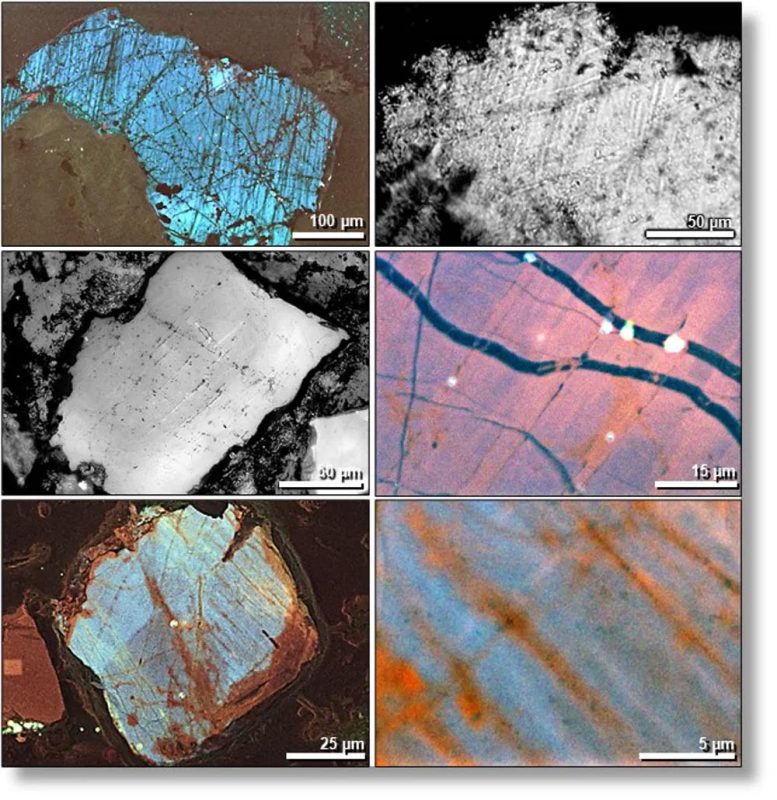
Electron microscope images of numerous small cracks in shocked quartz grains. Credit: Allen West
At the site, there are finely fractured sand grains called shocked quartz that only form at 725,000 pounds per square inch of pressure (5 gigapascals) – imagine six 68-ton Abrams military tanks stacked on your thumb.
The destruction layer also contains tiny diamonoids that, as the name indicates, are as hard as diamonds. Each one is smaller than a flu virus. It appears that wood and plants in the area were instantly turned into this diamond-like material by the fireball’s high pressures and temperatures.
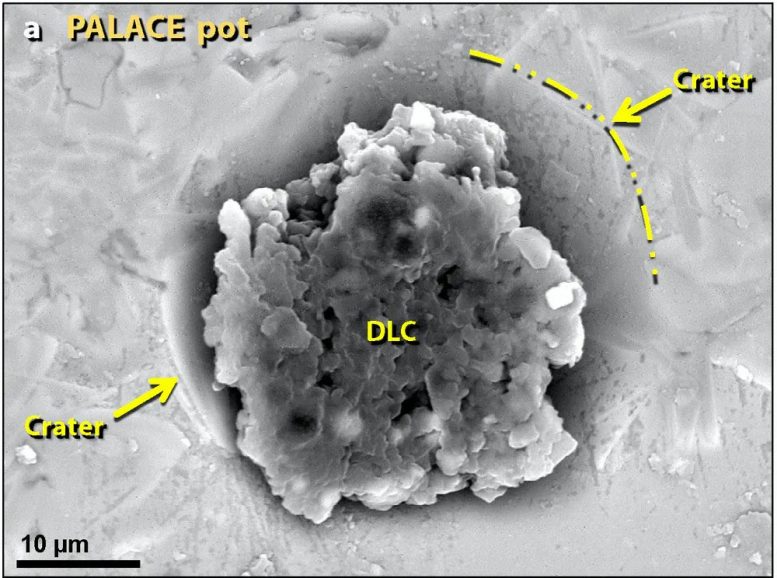
Diamonoids (center) inside a crater were formed by the fireball’s high temperatures and pressures on wood and plants. Credit: Malcolm LeCompte
Experiments with laboratory furnaces showed that the bubbled pottery and mudbricks at Tall el-Hammam liquefied at temperatures above 2,700 F (1,500 C). That’s hot enough to melt an automobile within minutes.
The destruction layer also contains tiny balls of melted material smaller than airborne dust particles. Called spherules, they are made of vaporized iron and sand that melted at about 2,900 F (1,590 C).
In addition, the surfaces of the pottery and meltglass are speckled with tiny melted metallic grains, including iridium with a melting point of 4,435 F (2,466 C), platinum that melts at 3,215 F (1,768 C) and zirconium silicate at 2,800 F (1,540 C).

Spherules made of melted sand (upper left), palace plaster (upper right) and melted metal (bottom two). Credit: Malcolm LeCompte
Together, all this evidence shows that temperatures in the city rose higher than those of volcanoes, warfare and normal city fires. The only natural process left is a cosmic impact.
The same evidence is found at known impact sites, such as Tunguska and the Chicxulub crater, created by the asteroid that triggered the dinosaur extinction.
One remaining puzzle is why the city and over 100 other area settlements were abandoned for several centuries after this devastation. It may be that high levels of salt deposited during the impact event made it impossible to grow crops. We’re not certain yet, but we think the explosion may have vaporized or splashed toxic levels of Dead Sea salt water across the valley. Without crops, no one could live in the valley for up to 600 years, until the minimal rainfall in this desert-like climate washed the salt out of the fields.
Was there a surviving eyewitness to the blast? It’s possible that an oral description of the city’s destruction may have been handed down for generations until it was recorded as the story of Biblical Sodom. The Bible describes the devastation of an urban center near the Dead Sea – stones and fire fell from the sky, more than one city was destroyed, thick smoke rose from the fires and city inhabitants were killed.
Could this be an ancient eyewitness account? If so, the destruction of Tall el-Hammam may be the second-oldest destruction of a human settlement by a cosmic impact event, after the village of Abu Hureyra in Syria about 12,800 years ago. Importantly, it may the first written record of such a catastrophic event.
The scary thing is, it almost certainly won’t be the last time a human city meets this fate.

Animation depicting the positions of known near-Earth objects at points in time for the 20 years ending in January 2018. Credit: NASA/JPL-Caltech
Tunguska-sized airbursts, such as the one that occurred at Tall el-Hammam, can devastate entire cities and regions, and they pose a severe modern-day hazard. As of September 2021, there are more than 26,000 known near-Earth asteroids and a hundred short-period near-Earth comets. One will inevitably crash into the Earth. Millions more remain undetected, and some may be headed toward the Earth now.
Unless orbiting or ground-based telescopes detect these rogue objects, the world may have no warning, just like the people of Tall el-Hammam.
Written by Christopher R. Moore, Archaeologist and Special Projects Director at the Savannah River Archaeological Research Program and South Carolina Institute for Archaeology and Anthropology, University of South Carolina.
This article was co-authored by research collaborators archaeologist Phil Silvia, geophysicist Allen West, geologist Ted Bunch and space physicist Malcolm LeCompte.
This article was first published in The Conversation. For more on this research, see Sodom and Gomorrah? Evidence That a Cosmic Impact Destroyed a Biblical City in the Jordan Valley.
I don't know what was their greatest sin. (Although I agree that Our Lord made plain that offenses against charity--which cover a wide range of bad actions--is the grandaddy of all sin.) We just know that sodomy was enough, and was the matter at hand.
Before this, you had Abraham bargaining God down, saying, "Lord, what if I find TEN just men--then will you then spare the city?" It is then that the narrator recounts with apparent emphasis how the men of Sodom repeatedly demanded that Lot introduce them to those men, who were actually messengers from God (angels), "that we may know them." The Sodomites use that same verb every time as the group grows larger and larger, threatening Lot for holding the door against them--finally surrounding the house until every male in the city is among them, and Lot is entreating them not to "act so wickedly"--and offering them two young girls instead. They refuse that offer, furious that this "sojourner" would "play the judge" with them and roaring, "Stand back!"
That's when the angels pull Lot inside the house with them, hold the door themselves with no apparent effort and strike all the besiegers blind.
That's what makes it plain which meaning of the word "know" the narrator is intending--it's not an ordinary howdy-do--and that not even one man in Sodom was innocent of it. And that it was enough to merit what followed.
That it was before the unveiling of the Big 10 is not material here. Murder was recognized as a sin (Thanks, Cain!) long before the Ten Commandments, so it's not a shocker that sodomy was also. It is plainly stealing and corrupting a mystery given to us by God.
God is not a “Giant Space Rock.”
_______________________
God can and will use any means that He wishes, including burning bushes, talking donkeys, floods, rainbows,or space rocks to communicate. He is still in control and is not limited in methods He use.
1600 BC is right around the time of the Bronze Age Collapse. I’m surprised that the Egyptians didn’t make a record of it.
Oops, I stand corrected. The Bronze Age Collapse wasn’t for another 400 years. I’m still surprised that the Egyptians hadn’t made a record of it. They’re usually meticulous about such things.
That’s what I was thinking.
A giant space rock, because G-d said.
Reminds me of when I Japanese friend was trying to translate his Japanese to English.. He said “Head Panic!”.
I LoL’ed and told him that would be a great name for a Japanese band..
https://en.wikipedia.org/wiki/Sodom_and_Gomorrah
https://en.wikipedia.org/wiki/Admah
https://en.wikipedia.org/wiki/Zeboim_(Hebrew_Bible)
https://en.wikipedia.org/wiki/Zoara
[snip] During the Crusader period it took the name of Palmer, or of Paumier. William of Tyre (XXII, 30) and Fulcher of Chartres (Hist. hierosol., V) have left descriptions of it, as well as the Arabian geographers, who highly praise the sweetness of its dates.[6] It is not known when the city disappeared;[11]
According to the 14th century travelogue The Travels Of Sir John Mandeville:
“Zoar, by the prayer of Lot, was saved and kept a great while, for it was set upon a hill; and yet sheweth thereof some part above the water, and men may see the walls when it is fair weather and clear.”[13] [/snip]
[’Civ note: Search for Sodom & Gomorrah, True Adventure Dead Sea-w/Photos by Ralph E Baney was researched in the 1950s, and the dives were in the much more shallow southern basin, where he found at least one “genie bottle” shaped underground structure (by accident, it gave him quite a scare).]
Biblical Problems with Identifying Tall el-Hammam as Sodom
Simon Turpin
https://answersresearchjournal.org/identifying-tall-el-hammam-sodom/
https://assets.answersingenesis.org/doc/articles/pdf-versions/arj/v14/tall-el-hammam_sodom.pdf
And folks try to claim that a planet is not missing from orbit and our system. That animation is pretty much tell all, pretty obvious for even a fourth grader. It was destroyed and these are all that is left. They also claim not enough combined mass there, most probably went out away from the suns gravity and our solar system.
The people reporting what was found are not acknowledging God had anything to do with it
Instead they INFER as in GUESS it was some sort of Blob from Space.
The material found is fact.
The “Space Rock” is a “story”, an “inference”, an exercise in “speculation.”
The problem is people are led to believe the “story” is somehow a “fact.”
An honest report would describe the elements found, the location where found, and leave out the “Space Rock” part. The report might describe the biblical account and call it interesting. “Isn’t that interesting?”
If asked by the readers HOW did it happen? An honest answer would be THE HOW IS UNKNOWN. But because so many today are know-it-alls, the jerk reaction is to pull it out of the butt and sensationalize it.
I watched his show once. Hilarious.
Great post, great comments, Rashi and SMOD, and yes it is valid and makes sense. FR is the greatest spot on the internet, just ❤️ you guys!
D.C. ..........................
Or has already fallen into the Sun and other planets, like Jupiter et al...............
Maybe they did.........................
Thanks Red B! Interesting article.
Yep... That visual is hard to argue with. I’m sure you have read Sitchin’s studies about the metaphorical ancient Sumerian account of this happening as Marduk impacting Tiamat. Ancient knowledge passed down to the Sumerians?
https://www.sitchinstudies.com/sumerian-solar-system.html
Disclaimer: Opinions posted on Free Republic are those of the individual posters and do not necessarily represent the opinion of Free Republic or its management. All materials posted herein are protected by copyright law and the exemption for fair use of copyrighted works.